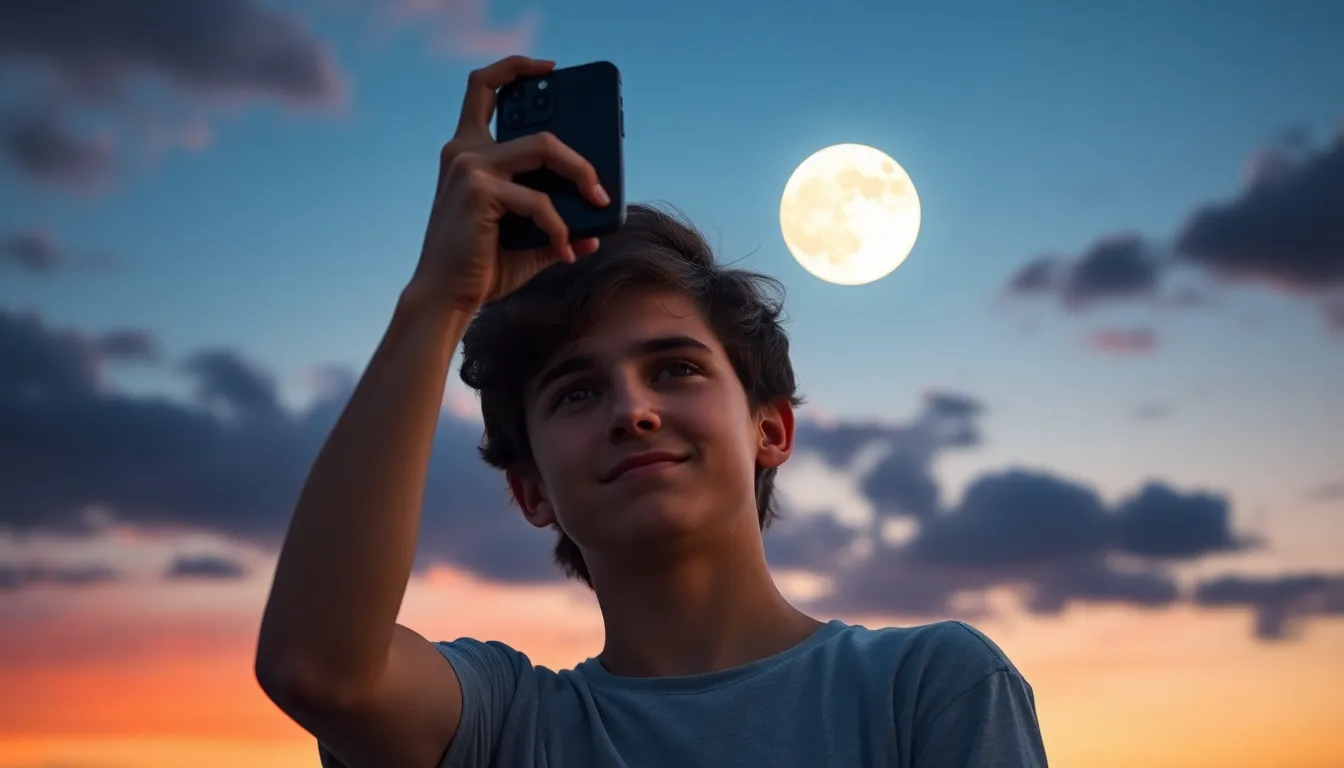Capturing the moon with an iPhone 12 might seem like a task reserved for professional photographers or those with fancy equipment. But fear not! With a few simple tricks up your sleeve, you can snap stunning lunar photos that’ll make your friends think you’ve got a telescope hidden in your pocket.
Table of Contents
ToggleUnderstanding Your iPhone 12 Camera
The iPhone 12 features advanced camera capabilities that enhance its ability to capture the moon. Knowing these features helps in achieving stunning lunar photographs.
Key Features for Astrophotography
Night mode stands out as a crucial element for low-light photography. This feature automatically adjusts settings to provide clearer images in dark conditions. Additionally, the wide and ultra-wide lenses offer flexibility in framing shots. Both lenses help capture more of the surrounding sky along with the moon. The Smart HDR technology enhances details in bright and shadowy areas. Using this feature, photographers can maintain clarity in various lighting conditions while photographing the lunar surface.
Camera Modes to Use
Utilizing the photo mode is essential for regular moon photography. Switching to night mode enables optimal settings for low-light situations. Portrait mode may not be suitable for moon shots but can be great for capturing the environment around it. Zooming in on the moon using the telephoto lens provides a closer, detailed view. Enabling grid lines through settings helps in perfectly framing the subject. Each mode offers unique advantages that contribute to capturing breathtaking images of the moon.
Preparing for the Shoot

Preparing for a successful moon shoot involves careful planning and consideration. By focusing on timing and location, photographers can enhance their chances of capturing stunning lunar images.
Best Time to Photograph the Moon
The best time to photograph the moon occurs during its waxing or waning phases. Aim for just after sunset or right before sunrise, as the moon’s presence alongside the horizon creates dramatic images. Avoid full moon days, as the bright light can wash out details. Checking a lunar calendar facilitates finding the ideal dates. The golden hour, shortly after sunrise or before sunset, also enhances the scene. Creating depth through foreground elements enriches compositions. Using apps that track lunar phases and rise/set times helps plan the shoot precisely.
Choosing the Right Location
Selecting the right location significantly impacts moon photography. Look for places with unobstructed views of the horizon, such as beaches or elevated parks. Remote areas away from city lights enhance visibility and reduce light pollution. Ensure accessibility for easy setup, along with safety considerations after dark. Natural landscapes, including mountains or trees, add context and depth to images. Using satellite imagery provides insight into terrain and potential shooting angles. Arriving early allows for scouting and composing shots. Creating a checklist of ideal spots can streamline the planning process.
Setting Up Your iPhone 12
Setting up your iPhone 12 for moon photography involves adjusting specific settings and utilizing the right equipment to ensure stunning results.
Adjusting Camera Settings
Access the camera app to begin optimizing settings. Night mode activates automatically in low-light conditions. Use this feature for sharper details of the moon. Enable grid lines in the camera settings for better composition and alignment. Focus settings also play a role; tap the moon in the viewfinder to ensure it’s the primary subject. Adjust exposure by sliding the sun icon up or down based on the desired brightness level. Utilizing Smart HDR enhances the dynamic range, capturing both bright and dark areas. For extra zoom, switch to the telephoto lens if available, providing closer shots without losing detail.
Using Tripods and Stabilization Techniques
Stabilisers enhance image quality by eliminating shake. Consider using a tripod for stability when photographing the moon. A sturdy tripod holds the iPhone steady, which is especially useful during longer exposures. If a tripod isn’t available, try stabilizing the phone against a solid surface, like a wall or rock. Alternatively, utilize the self-timer function to minimize camera movement when pressing the shutter button. Choosing a location with minimal wind can also help reduce vibrations. Implement these techniques to elevate the quality of moon photographs.
Taking the Perfect Shot
Capturing the moon’s beauty requires attention to detail and thoughtful composition. Achieving stunning results becomes simpler with specific techniques and adjustments.
Tips for Composition
Incorporate interesting foreground elements to enhance the lunar image. Intriguing trees or buildings add depth. Use the rule of thirds for balanced framing; position the moon off-center for more dynamic images. Consider capturing the moon during golden hour for warmer colors in the sky. Experiment with different angles to discover unique perspectives. Include natural landscapes to provide context and scale. Prioritize clarity by avoiding cluttered backgrounds.
Focus and Exposure Adjustments
Focusing on the moon can be challenging. Tap the moon on the iPhone 12 screen for precise focus adjustment. Adjust exposure by sliding your finger up or down on the screen; this fine-tuning enhances image details. Utilize Night mode for improved brightness and clarity in low-light settings. Compact clouds can create dramatic effects, so don’t hesitate to wait for the right moment. Check for wind, which can cause vibrations; a steady shot captures more definition. Stabilize the iPhone 12 on a solid surface if a tripod isn’t available, ensuring quality photos.
Editing Your Moon Photographs
Editing enhances moon photographs taken with the iPhone 12, bringing out details and improving aesthetics. Employing the right tools and techniques can transform good images into stunning visuals.
Recommended Apps for Enhancement
Utilize popular photo-editing apps like Adobe Lightroom, Snapseed, or VSCO. Each app provides powerful filters and adjustment tools tailored for mobile photography. They allow users to fine-tune contrast, brightness, and saturation levels for dramatic effects. Lightroom’s selective editing capabilities enable precise adjustments to specific photo areas. Snapseed’s healing tool can remove imperfections, while VSCO offers presets that enhance colors nicely. Experimenting with these apps ensures a personalized touch for every photograph.
Basic Editing Techniques
Start by cropping photos to focus on the moon better, eliminating unnecessary elements. Adjust brightness levels to highlight lunar details, avoiding overexposure that can wash out clarity. Increase contrast to emphasize texture on the moon’s surface, providing depth and dimension. Fine-tune colors to ensure the image reflects realistic hues, especially during golden hour. Sharpening enhances details, making the moon stand out against the night sky. Use filters sparingly; subtlety often enhances the overall appeal without overwhelming the image.
Capturing stunning moon photos with an iPhone 12 is both achievable and rewarding. With the right techniques and settings, anyone can create impressive images that showcase the beauty of the lunar landscape. By focusing on preparation and utilizing the iPhone’s advanced camera features, photographers can enhance their skills and produce captivating shots.
Experimenting with composition and timing can lead to unique perspectives and dramatic effects. After the shoot, editing the images can further elevate their quality, ensuring the moon stands out beautifully. With practice and creativity, anyone can master moon photography and enjoy the process of capturing this celestial wonder.






